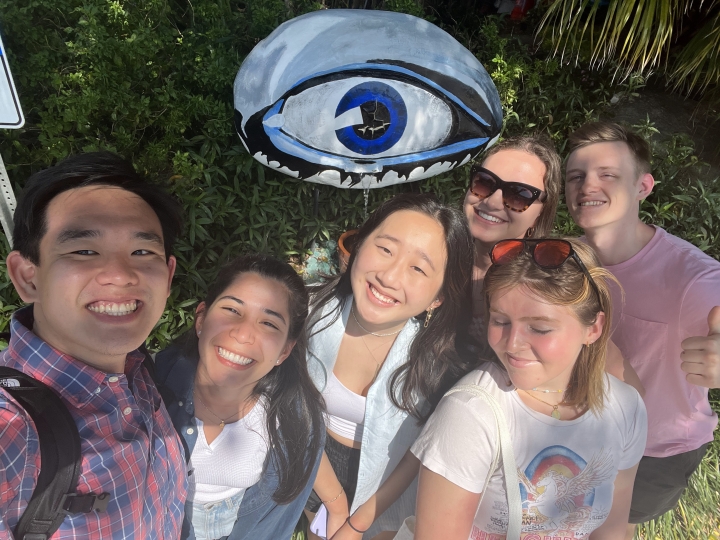A digital, interactive museum experience designed by the Digital Applied Learning and Innovation (DALI) Lab is attracting eyeballs.
Working in conjunction with The Dalí Museum in St. Petersburg, Fla., a team of Dartmouth students has used eye-tracking technology to create a computer program that captures the viewer’s gaze as they view artwork by Salvador Dalí, a leading figure in the Surrealist movement.
The program examines how people look at paintings, says Tim Tregubov, director and co-founder of the DALI Lab, and aims to enhance their understanding and experience of the art.
As viewers take in the details of a Dalí painting of their choice, the app follows and records their wandering eyes. This offers a rare window into how people look at paintings—which themes or colors draw the most attention, where the eyes linger and for how long.
After a year of research, software development, and digital design, the program had its first test run over spring break. Project manager Donia Tung ’22, software engineers Julian Wu ’22, Devon Starr ’25, and Isabella Hochschild ’25, and user experience designers Jennifer Xu ’23 and Tatum Teodori ’22 traveled to The Dalí to continue finessing the program alongside the museum staff they have been working with virtually to-date.
Every term at the DALI Lab, more than 85 students work on projects in teams of designers, software engineers, and a project manager. Student mentors and staff provide an exciting, fast-paced, and supportive learning environment where students create digital solutions for partners around the world.
“It was exciting and very gratifying to watch our partners at the museum test out the project for the very first time,” says Tung. A major in computer science and history modified with women, gender, and sexuality studies, Tung is interested in exploring how computer science and emerging technologies can be used to facilitate storytelling, and describes the project as “a culmination of everything that I’ve ever been interested in.”
Teodori, an engineering and studio art major, was also drawn to the project because it blended technology and art. She worked on the project from the start, from conducting preliminary research on digital exhibits to creating the look and feel of the experience with the other designers on the team. It was rewarding, she says, and a valuable lesson on how to work with clients.
Interactive exhibits at natural history and science museums were always a big draw for Wu, a computer science and economics major. The opportunity to build a personalized experience for museumgoers was what attracted the computer science and economics major to the project. He hopes that visitors enjoy giving the eye-tracking technology a whirl as they learn about art.
Besides sharpening students’ technical and design skills, the project also enabled them to acquire a rich amount of domain knowledge about the physiology of vision, Dalí’s art, and museum curation to create a compelling digital design solution, says Tregubov.
It was challenging to develop code for a new, cutting-edge hardware, which didn’t come with a ton of documentation, says Wu. What was more daunting, he says, “was building something that hundreds or thousands of people will see and use someday. Everything has to be pixel perfect.”
The Dalí was introduced to Dartmouth’s DALI Lab when the museum hosted Eric Fossum, the vice provost for entrepreneurship and technology transfer, for a talk in 2019. It’s not a coincidence the two entities share a similar name, though. The choice of the acronym for the digital arts lab was deliberate, a hat-tip to Dalí and the avant-garde.
The museum was intrigued by the DALI Lab’s work and mission and began discussing collaboration ideas, ultimately landing on the eye-tracking project.
The Dalí is more than a museum; it is a laboratory in which to experiment with new ways of thinking, says Dalí Museum Executive Director Hank Hine.
“This collaboration with Dartmouth’s DALI Lab program and students provided an avenue to begin studying a topic we’ve long been interested in exploring,” he says. “And it paired harmoniously with our dedication to both education and to developing experiences that blend art and technology.”


